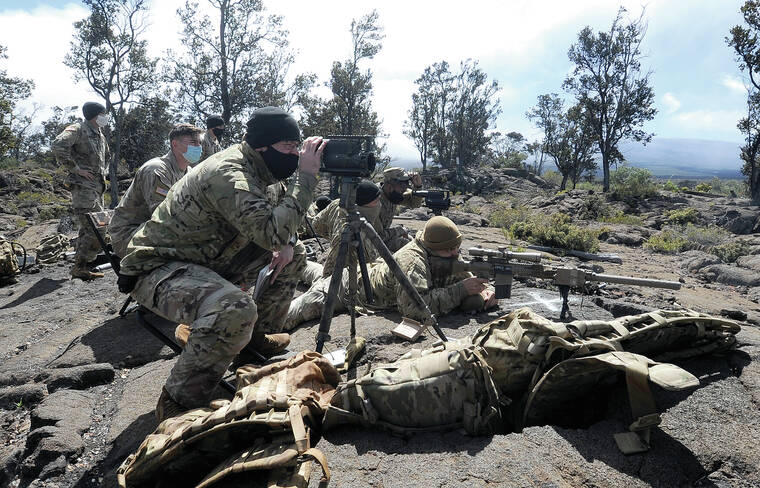HILO, Hawai‘i — A draft environmental impact statement released earlier this month about the Army’s proposal to renew its lease on up to 22,750 acres of state land at Pohakuloa Training Area indicated that granting the extension could have an adverse impact on Hawaiian cultural practices and environmental justice.
The state and the Army signed the current 65-year lease in 1964. The Army paid $1 for its use of the ceded lands — which were crown lands during the Hawaiian monarchy. That lease, which expires on Aug. 16, 2029, is for almost 23,000 acres of the 132,000-acre military training installation in the Big Island’s “Saddle” area. Since 2017, the Army has worked almost continuously on renewal of the lease.
This is the second draft of the environmental document; the first was published in 2022. A final EIS would be the next step.
“The Army proposes to retain up to 22,750 acres of state-owned land in support of continued military training,” said Group 70 International, the consultant for the EIS, in the document’s action summary.
“The retention will preserve maneuver area, provide austere environment training, enable access between major parcels of U.S. government-owned land, retain infrastructure investments, allow for future modernization, and maximize use of the impact area.
“Loss of this land would impact the ability of the Army to meet training requirements and its mission of readiness.”
Another 250 acres currently leased but not in the renewal proposal are administered by the Department of Hawaiian Home Lands.
The draft EIS contains four alternatives for lease renewal, including renewing all but 250 acres, to renewing a little more than 10,000 acres. The alternative reportedly favored by the Army is one that would retain about 19,700 acres, or 86 percent of the state-owned land at PTA, including all U.S. government-owned facilities, utilities and infrastructure within the state-owned area to be retained.
There is opposition among some Native Hawaiians and peace activists to the leasing of ceded lands to the Army for military training, and that opposition has grown more vocal in recent years.
In 2014, Clarence Ching and Maxine Kahaulelio, Native Hawaiian cultural practitioners, successfully sued the state Department of Land and Natural Resources, claiming the state failed to conduct regular monitoring and inspections of the land at PTA to prevent the area from “falling into ruin.”
Their 2015 trial in Honolulu Circuit Court confirmed the existence of military debris, including unexploded ordnance, at the Army training site.
The state appealed the ruling, and the Hawai‘i Supreme Court, in a 5-0 vote in 2019, affirmed the lower court’s ruling. The Army wasn’t a defendant in that suit.
The Board of Land and Natural Resources (BLNR), which is the approving agency for the EIS, also is in the process of entertaining a land swap with the Army of federal lands for the ceded lands the Army says are vital to its mission of training military forces from all branches, as well as allied nations.
On April 12, testifiers overwhelmingly urged the BLNR to reject a land swap for the Pohakuloa ceded lands, as well as state lands used by the military elsewhere.
Gen. Charles Flynn told the board Hawai‘i’s location presents key strategic value for the Army, allowing it to project force and respond to threats and disasters in the Pacific. PTA, in particular, is “one of the most important training areas for the entire country,” he said.
On O‘ahu, the Army also leases about 50,000 acres across 18 different sites — including the Kahuku Training Area, Schofield Barracks and Dillingham Airfield — and is also engaged in its land retention process for those areas.
No decision came from the BLNR meeting.
Jim Albertini, a Kurtistown farmer and peace activist who has long opposed the Army’s presence at PTA, remains opposed to the military’s continued use of the land.
“Tell them no new lease. No land swap, etc.,” Albertini said in an email last week. “Clean up the military mess at PTA, and return the land to the Hawaiian people like Kaho‘olawe. But do a much better clean-up job than was done on Kaho‘olawe.”
There are two public meetings scheduled for the Big Island on the draft EIS. The first is set for 6-8 p.m. Monday, May 6, at Waimea District Park. The second is at 6-8 p.m. Tuesday, May 7, at ‘Imiloa Astronomy Center in Hilo.
Albertini believes the number and format of the meetings are insufficient for public engagement and feedback.
“These are public meetings but should be public hearings where the community can listen to each others’ testimony instead of being told to go over in the corner and record your statement with a stenographer,” he said. “And instead of just two meetings on the Big Island, there should be public hearings in every one of the nine districts on Hawai‘i Island.”
The release of the draft EIS triggered a 45-day public review and comment period, as well. Comments are due by June 7. To comment online, visit https://bit.ly/3y59IL2.


